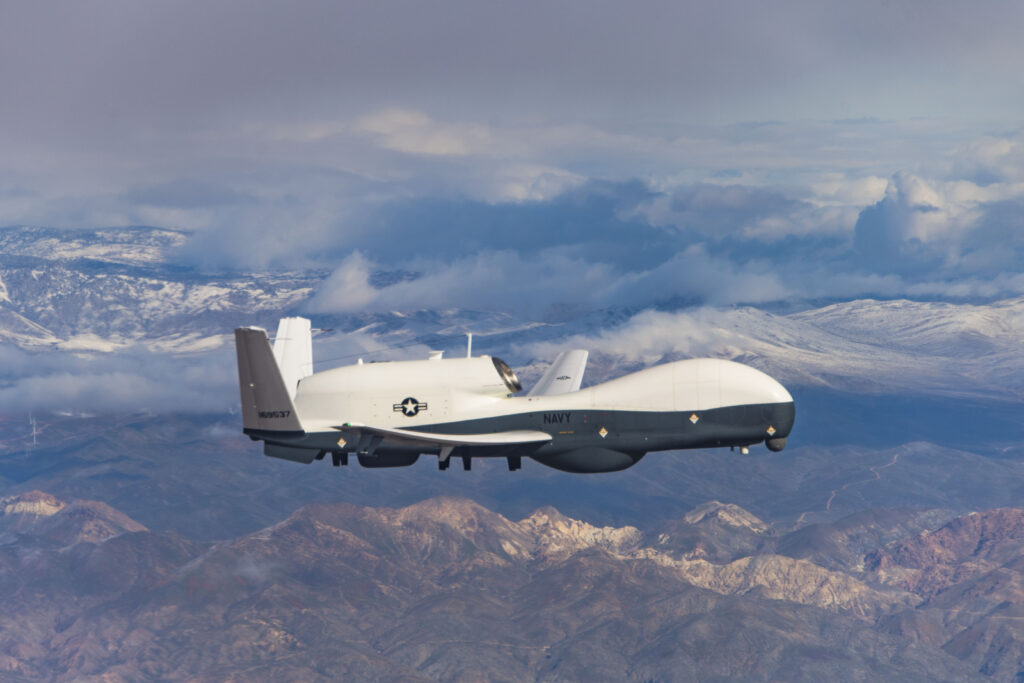
*****
ARLINGTON, Va. — The U.S. Navy is planning to reduce the number of planned deployment sites for its MQ-4C Triton high-altitude, long-endurance unmanned aerial vehicles in accordance with its planned reduction in the number of Tritons being procured.
“FY24 quantity is being reduced from four to two aircraft; a total program of record procurement is being reduced from 70 aircraft to 27,” said a Navy spokesperson in response to a query from Seapower. “This quantity reduction is based on the Joint Requirements Oversite Council re-evaluation of worldwide ISR&T [intelligence, surveillance, reconnaissance, and targeting] requirements that resulted in direction to reduce total MQ-4C deployable locations (orbits) from five to three.”
The Navy had originally planned to establish orbits in Jacksonville, Florida; Whidbey Island, Washington; Sigonella, Sicily; Guam; and a base in the U.S. Central Command area of responsibility. The Navy did not specify which three sites were still planned for the Triton.
At five orbits and four Tritons per orbit — able to keep an aircraft on station 24/7 — the 20 aircraft required was far lower than the planned for procurement of 70. The original planned procurement would have allowed the Navy to purchase them at economic quantities, keep some in storage, and to sustain Triton operations over many years as the early aircraft reached the end of their service lives.
With three orbits, the total number of 12 Tritons required to sustain them would leave 15 available for attrition, training, and depot-level maintenance.
“When determining the number of air vehicles for a program of record, attrition is a part of the equation when considering the lifespan of the program,” the spokesperson said.
Unmanned Patrol Squadron (VUP) 19, home-based at Naval Air Station Jacksonville, Florida, deployed two MQ-4Cs to Andersen Air Force Base in Guam in 2020 to provide MISR&T for the U.S. 7th Fleet while developing the concept of operations and the tactics to refine the Triton’s operations. The detachment operated from Guam; Naval Air Facility Misawa, Japan; and Marine Corps Air Station Iwakuni, Japan, the Navy said in a March 16 release. The detachment returned from deployment in March.
The two deployed Tritons were of the baseline Integrated Functional Capability (IFC) 3 configuration. The squadron has since received newer versions in the IFC 4 configuration, which are equipped with a more capable sensor suite that will allow them to replace the Navy’s fleet of EP-3E Orion electronic reconnaissance aircraft. The MQ-4C will supplement the Navy’s P-8A Poseidon maritime patrol aircraft.
VUP-19 is bringing the Triton to Initial Operational Capability in 2023 with the establishment of an orbit in Guam in support of the 7th Fleet’s Task Force 72.
Northrop Grumman delivered the fourth IFC 4 Triton to the squadron in May to complete the set of aircraft for the Guam orbit while the first aircraft for the second orbit is scheduled to deliver in June, according to Rho Cauley-Bruner, director, Triton program.
- SECNAV Advocates Increased Legal Immigration to Increase Shipbuilder Workforce - April 23, 2024
- Insitu Going Strong at 30, Focusing on Maritime Operations - April 8, 2024
- Navy Awards Boeing Additional Funds for MQ-25 Drones for Testing - April 3, 2024






